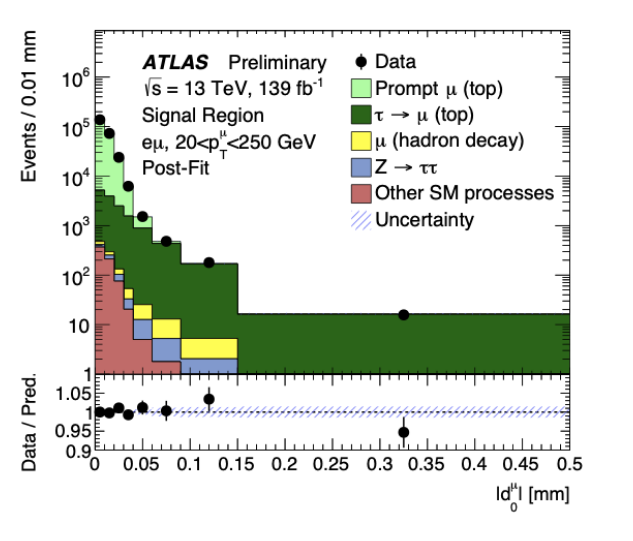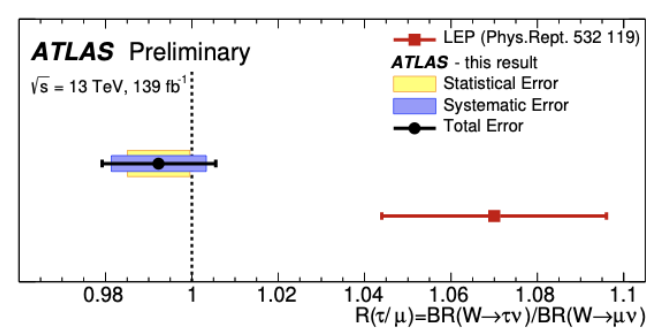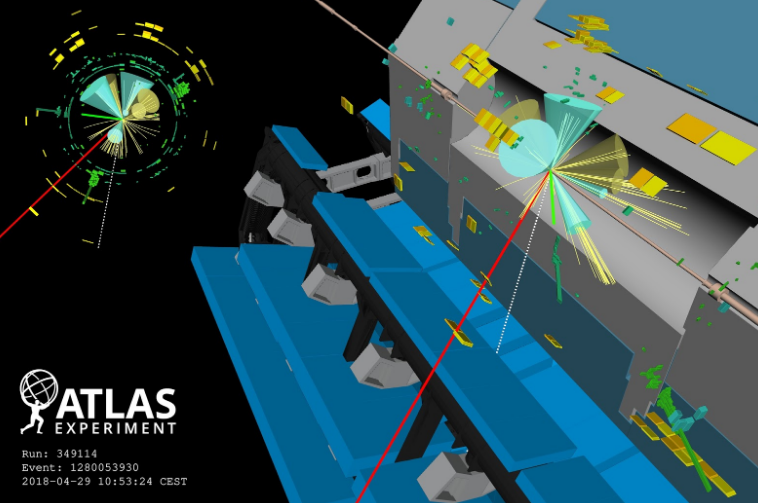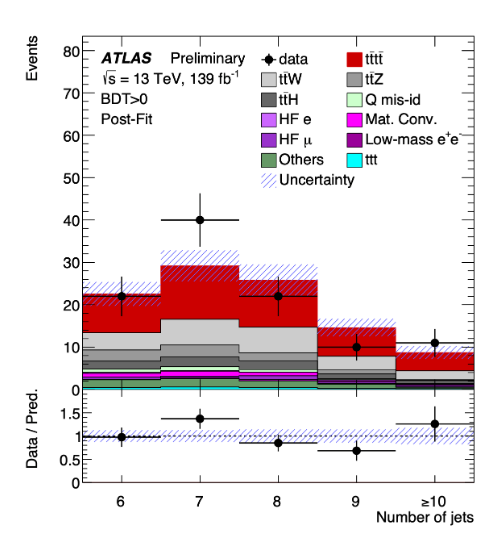ATLAS results: from precision to rarity

Two recent ATLAS results that showcase the full range of the ATLAS physics potential, from precision to rarity, were shown at LHCP and presented at a recent CERN LHC seminar. A test of the universality of τ and μ lepton couplings in W boson decays from tt̅ events [1] and first evidence for ttt̄t production in the multilepton final state [2].
These results span five orders of magnitude in the process production cross section. Of order 100 million tt̅ events and 1000 ttt̄t events were produced during Run 2. Performing physics analyses across this range is a test of ATLAS as well as the Standard Model.
Lepton Flavor Universality
The family of charged leptons is composed of the electron, muon (μ) and tau-lepton (τ) (and their antiparticles) -- the three lepton flavours. According to the Standard Model (SM), these particles only differ in their mass. It is a remarkable feature of the Standard Model that each flavour is equally likely (“universal”) to interact with a W boson, this is known as Lepton Flavour Universality.
In a new ATLAS measurement [1] a novel technique using top quark pair events is exploited to test the relative probability of tau-leptons and muons to be produced in W boson decays, R(τ/μ). In the SM R(τ/μ) is expected to be unity, however a long-standing tension with this prediction has existed since LEP where, from a combination of the four experiments, R(τ/μ) was measured to be 1.070 ± 0.026 [3], deviating from the SM expectation by 2.7σ. This strongly motivates the need for new measurements with higher precision.
To conclusively prove either that the LEP discrepancy is real or that it was just a statistical fluctuation, a precision of at least 1–2% is required. If the LEP measurement were to be confirmed with this level of precision it would correspond to an unambiguous discovery of beyond the Standard Model physics.
The key to achieving this level of precision is to obtain a sample muons and taus from W boson decays that are largely insensitive to the details, and therefore systematic uncertainties, related to the trigger and object reconstruction used to select them. This is achieved in the new ATLAS measurement by using tt̄ events which contain two W bosons from the top quark decays. In a tag-and-probe approach, one W boson is used to select the events and the other is used, independently of the first, to measure the fractions of decays to tau-leptons and muons in an unbiased way.
The analysis focuses on tau-lepton decays to a muon, rather than hadronic tau decays which are more complicated to reconstruct, thus reducing the systematic uncertainties associated with the object reconstruction. The lifetime of the tau lepton and its lower momentum decay products are exploited by the precise muon reconstruction available from the ATLAS detector to separate muons from tau-lepton decays (τ→μ) and muons produced directly by a W decay (prompt μ). Specifically, the absolute distance of closest approach of muon tracks in the plane perpendicular to the beam line, |d0μ| (as shown in the left figure), and the transverse momentum, pTμ, of the muons are used to isolate these contributions. These variables, in particular |d0μ|, are calibrated using a pure sample of prompt muons from Z→μμ data.

Figure 1: An example |d0μ| distribution (in the eμ-channel for the highest pTμ bin) after the fit to data has been performed. This shows the separation power between prompt μ and (τ→μ) contributions.
The extraction of R(τ/μ) is performed using a fit to |d0μ| and pTμ where cancellation of several systematic uncertainties is observed as they are correlated between the prompt μ and τ→μ contributions. This includes for example, uncertainties related to jet reconstruction, flavour tagging and trigger efficiencies. As a result, the measurement obtains very high precision, surpassing that of the previous LEP measurement.

Figure 2: A comparison of this measurement to that from LEP. The vertical dashed line indicates equal branching ratios to different lepton flavours.
The measured value is R(τ/μ) = 0.992 ± 0.013 [±0.007 (stat) ± 0.011 (syst)], forming the most precise measurement of this ratio, with an uncertainty half the size of that from the combination of LEP results (see right-hand figure). It is in agreement with the Standard Model expectation and suggests that the previous LEP discrepancy may be due to a fluctuation. The SM survives this latest test of universal lepton couplings!
Four tops
The ATLAS Collaboration recently announced strong evidence of the production of four top quarks. This rare Standard Model process is expected to occur only once for every 70 thousand pairs of top quarks created at the LHC and has proven extremely difficult to measure.

Figure 3: Event display of a candidate four-top-quark event, where two of the top quarks decay leptonically (one with a resulting muon (red) and one with an electron (green)), and two top quarks decay hadronically (green and yellow rectangles). The jets (b-tagged jets) are shown as yellow (blue) cones.
The top quark is the most massive elementary particle in the Standard Model, clocking in at 173 GeV, so when four top quarks are produced in a single event, they create the heaviest particle final state ever seen at the LHC, with almost 700 GeV in total. This is an ideal environment to search for new physics with yet unknown particles contributing to the process. Should they exist, physicists will see additional production of four top quarks above what is predicted by the Standard Model, further motivating a detailed study of the process.
In this new search for four-top-quark production, ATLAS physicists studied the full Run 2 dataset recorded between 2015 and 2018. The four top quarks produce four W bosons and four jets originating from bottom quarks. The W bosons then, in turn, each decay into two jets or one charged lepton (electron, muon or tau leptons) and an invisible neutrino. As a final step, the tau leptons decay into a lighter lepton or a jet, with additional neutrinos. All this leaves spectacular signatures in the ATLAS detector.

Figure 4: The boosted decision tree (BDT) score output for the signal region (SR). The data are shown in black; the simulated signal in red. The y-axis shows the number of events and is in the logarithmic-scale. The band includes the total uncertainty on the post profile-likelihood fit (post-fit) computation. The ratio of the data to the total post-fit computation is shown in the lower panel.
For this result, physicists chose to focus on collision events producing two leptons with the same charge or three leptons. Despite accounting for only 12% of all four-top-quark decays, these signatures are easier to distinguish from background processes in the ATLAS detector. Detecting a signal nevertheless required a detailed understanding of the remaining background processes and the use of sophisticated separation techniques.
ATLAS physicists trained a multivariate discriminant (boosted decision tree) using the distinct features of the signal, including the high numbers of jets, their quark-flavour origin (bottom quark or not), and the energies and angular distributions of the measured particles. The main background processes that resemble the signal stem from the production of a pair of top quarks in association with other particles, such as a W or Z boson, a Higgs boson, or another top quark. Some of these processes have themselves only recently been observed by the ATLAS and CMS Collaborations.
Each background process was individually evaluated, primarily through dedicated simulations which included information from the best available theoretical predictions. The most difficult background processes – the top-quark-pair production with a W boson and backgrounds with fake leptons – had to be determined using data from dedicated control regions. Fake leptons arise when the charge of a lepton is misidentified, or when leptons come from a different process, but are attributed to the signal. Both had to be well-understood and precisely evaluated in order to reduce the systematic uncertainty on the final result.

Figure 5: Comparison between data and prediction for signal-region events with a BDT score greater than 0 for the distributions of the number of jets. The band includes the total uncertainty on the post profile-likelihood fit (post-fit) computation. The ratio of the data to the total post-fit computation is shown in the lower panel.
ATLAS measured the cross section for the production of four top quarks to be 24+7–6 fb, which is consistent with the Standard Model prediction (12 fb) at 1.7 standard deviations. The signal significance amounts to 4.3 standard deviations, for an expected significance of 2.4 standard deviations were the four-top-quark signal equal to the Standard Model prediction. The measurement provides strong evidence for this process.
Additional data from the next LHC run – along with further developments of the analysis techniques employed – will improve the precision of this challenging measurement.
Further reading:
[1] https://atlas.web.cern.ch/Atlas/GROUPS/PHYSICS/CONFNOTES/ATLAS-CONF-2020...
[2] https://atlas.web.cern.ch/Atlas/GROUPS/PHYSICS/CONFNOTES/ATLAS-CONF-2020...
[2] LEP Electroweak Working Group, Phys. Rept. 532 (2013) 119, arXiv:1302.3415.
